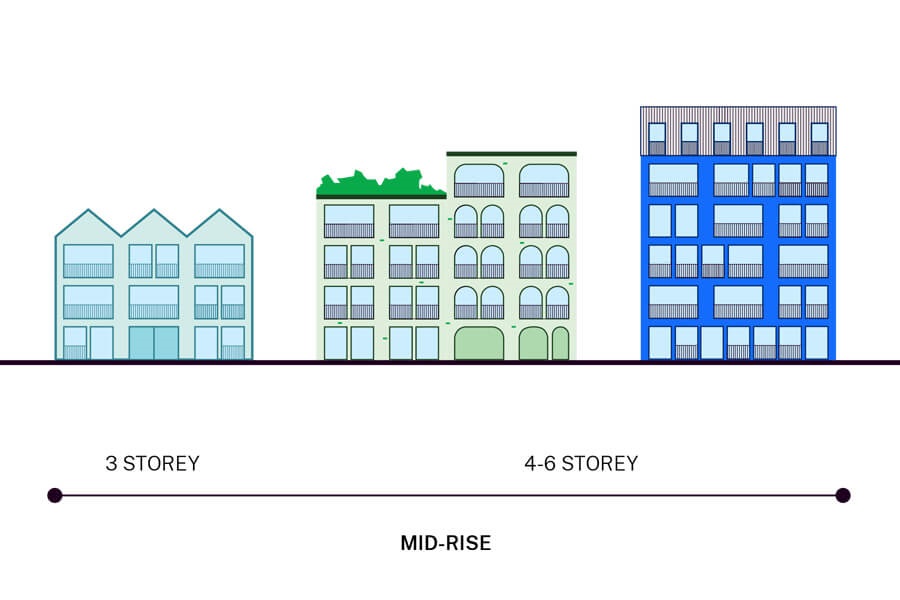NSW Government low to mid rise housing policy
Across 2024 and 2025, the NSW Government has introduced planning changes to encourage building types including terraces, townhouses, multi-unit dwellings and apartment buildings near stations and town centres. These are known as the Low and Mid-Rise reforms.
These reforms include:
- In July 2024, making dual occupancy development permissible in low density residential zones (without specifying a minimum lot size).
- In February 2025, implementing changes to encourage the development of other housing types within 800m of Ku-ring-gai train stations and St Ives town centre.
This page has been established to provide updates on this reform.
In 2024, Council held a series of community forums on this reform.
March 2025
At its March 2025 Ordinary Council meeting, Council voted to support a minimum lot size of 1,015 sq/m for dual occupancy developments on land zoned for Low Density Residential purposes.
This decision was made after Council considered feedback gathered during the exhibition of two minimum lot size options in January-February 2025.
While both options delivered the same level of housing, community feedback was clearly in favour of the 1,015 sq/m lot size, in part because it had less environmental and streetscape impacts.
This 1,015 sq/m minimum lot size is proposed to apply, by mid-2025, to eligible land located more than 800m from Ku-ring-gai’s railway stations (excluding Warrawee) and St Ives Local Centre.
Council’s resolution is subject to NSW Government endorsement. The introduction of the minimum lot size will be accompanied by fine-grain planning controls, which are still to be developed.
In the meantime, applications for dual occupancy development will be assessed on their merits, with applicants urged to discuss their application before lodgement with Council’s assessment team.
February 2025
The NSW Government announced on Friday 21 February that the second stage of its planning policy for new housing will commence on 28 February 2025.
On 28 February planning controls will be introduced by the government to allow dual occupancies, terraces, townhouses, apartments and shop top housing in low and mid-rise housing areas across Sydney.
The low and mid-rise housing areas are residential zones within 800 metres walking distance from town centres and train/light rail stations.
Within these areas, the new Low and Mid-Rise Housing Policy planning controls will apply to residential areas within 800 metres walking distance of 171 town centres and train stations across metropolitan Sydney.
NOTE: Council's Dual Occupancy minimum lot size will continue to apply. See Council's 18 March 2025 report here.
View a map of the areas in Ku-ring-gai
Planning controls applying to low and mid rise housing
Tree canopy guide for low and mid-rise housing(PDF, 3MB)
Previous updates
January 2025
Public exhibition - dual occupancy options in Ku-ring-gai
Ku-ring-gai Council is seeking feedback on the minimum lot size for dual occupancy development until 20 February 2025.
A dual occupancy development refers to two dwellings developed on one site. The dwellings can be attached or detached.
For dual occupancy to take place on a property, the site must meet the proposed minimum lot size.
Last year the NSW Government permitted dual occupancy housing on all land zoned R2 (Low Density Residential) across NSW.
Land which is bushfire prone, is a heritage item or is within a Transport Oriented Development area is excluded.
The NSW Government has provided Ku-ring-gai Council the opportunity to nominate minimum lot sizes for dual occupancy development to manage the impacts within established areas.
Council is seeking feedback on two options for minimum lot sizes that:
- Meet the NSW Government’s requirements to deliver dual occupancies on 50% of Council’s R2 (Low Density Residential) land; and
- seek to manage the impacts on Ku-ring-gai’s high quality garden character, including tall canopy trees and heritage conservation areas.
View the options and give feedback here.
The NSW Government’s dual occupancy planning rules will take effect in July 2025. Ku-ring-gai Council will consider the feedback received on the two dual occupancy minimum lot sizes before making a decision on the preferred option.
July 2024
On 1 July, the NSW Government announced it had made dual occupancy development permissible with development consent in most R2 low density residential zones. Dual occupancy development means two dwellings on one lot of land, whether the dwellings are attached or detached.
On 16 July, the Councilconsidered a Mayoral Minutewhich analysed recent planning reforms, including changed planning provisions for dual occupancies. Council resolved to ask staff to “review Ku-ring-gai’s planning controls for dual occupancy development (especially in regard to minimum lot sizes) and report back to Council with a view of updating the Local Environmental Plan and Development Control Plan prior to 30 June 2025”.
May 2024
At the Council meeting on 21 May 2024, Council considered a paper prepared by the NSW Department of Planning Housing & Infrastructure. This paper outlines the key issues identified in the public submissions to the Department regarding the policy, along with proposed refinements to address them. Each issue is addressed through one or more policy refinements, some of which the Department have stated they wish to collaborate one-on-one with councils to develop an appropriate policy position.
For details see Late Agenda of Ordinary Meeting of Council - Tuesday 21 May 2024
Key NSW Government links
Key Council links
Examples of low-rise housing

Examples of mid-rise housing
